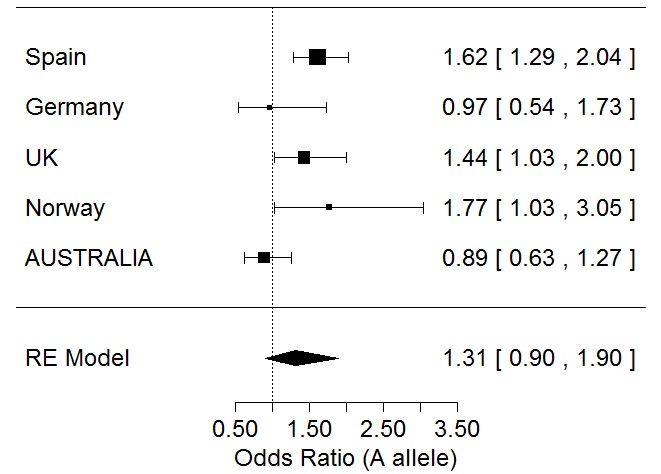Background/Purpose: The aetiology and genetic background of GCA remains unclear, although genetic susceptibility is known to play a role. Recently, an association with the minor, loss of function, allele of PTPN22 rs2476601 (R620W), was reported in a Spanish cohort of biopsy-proven GCA (odds ratio = 1.62, 95%CI 1.29-2.04, p = 0.0001)1. Therefore, dysregulation of TCR signalling may be implicated in the pathogenesis of GCA. The aim of this study was to determine the association between the PTPN22 rs2476601 minor (A) allele and biopsy-proven GCA in an Australian cohort.
Methods: rs2476601 genotyping was performed by a Taqman assay (C-16021387, Applied Biosystems) in 209 GCA cases. Genotype data from 1407 healthy ethnically-matched unrelated postmenopausal women included in the Anglo-Australian Osteoporosis Genetics Consortium study of bone density variation were used as healthy controls. All GCA cases were temporal artery biopsy proven, and were recruited in Australia by the Arthritis Genomics Recruitment Initiative in Australasia (AGRIA). The mean age of GCA patients at diagnosis was 73 yrs (SE 8 yrs), with 68% female.
Results: The frequency of the A allele was 0.093 in GCA cases and 0.103 in the controls. Overall, there was no evidence of an association between GCA and controls, (OR=0.89, 95% CI 0.63, 1.27, p = 0.52). A random effects meta-analysis of replication datasets from Germany1, Norway1, UK1, and Australia, included 769 GCA patients and 14,214 controls, did not reach statistical significance (OR 1.21, 95% CI 0.73, 2.00, p = 0.32). Similarly, a random effects meta-analysis which included the original Spanish dataset (1,392 GCA cases and 15,943 controls), also did not reach statistical significance (OR 1.31, 95% CI 0.90, 1.90, p = 0.11), Figure 1.
Conclusion: There was no statistically significant association between PTPN22 rs2476601 in this Australian GCA cohort. Nor does a meta-analysis of combined, available data reach statistical significance. However, an association with small effect size cannot yet be definitively excluded, and further studies may be required.
1. Serrano et al. Ann Rheum Dis 2013;72:1882-6.
Figure 1. Random Effects Meta-Analysis for the association between PTPN22 rs2476601 A allele and Giant Cell Arteritis
Disclosure:
S. Lester,
None;
A. Hewitt,
None;
L. Bradbury,
None;
E. De Smit,
None;
A. Harrison,
None;
G. Jones,
None;
G. O. Littlejohn,
None;
T. R. Merriman,
None;
B. Shenstone,
None;
M. D. Smith,
None;
M. Rischmueller,
None;
M. A. Brown,
None;
C. L. Hill,
None.
« Back to 2014 ACR/ARHP Annual Meeting
ACR Meeting Abstracts - https://acrabstracts.org/abstract/ptpn22-rs2476601-and-susceptibility-to-biopsy-proven-giant-cell-arteritis-gca-in-an-australian-sample/

